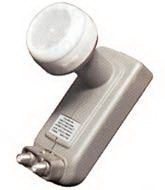Linear LNB
LNB stands for low noise blocker and it is essentially an amplifier on the end of your small satellite TV dish or communications dish. The “Linear” portion of Linear LNB stands for the characteristics of the radio waves that are transmitted via the satellite in space to your dish (LNB).
Two Types of Polarization
Circular Polarization
Circular polarization is a characteristic of radio waves that are transmitted from a satellite in space, in which the actual radio waves rotate in a spiral. The spiral of radio waves either rotates clockwise or counter clockwise. A great analogy of how circular radio waves approach your satellite dish (LNB) is by picturing an airplane propeller. The airplane propeller follows a specific path, but as it approaches the radio wave is spinning vertically.
Linear Polarization
Linear Polarization is the characteristic of radio wave in which the radio wave rotates on a single horizontal plane. A great analogy is instead of an airplane propeller, the radio wave approaches your satellite dish in the form of a helicopter rotor. The radio waves spin horizontally.
Besides the direction of the wave being either horizontal or vertical, satellite receivers usually only are able to work with one type of polarization. However, they are able to pick up both signals, the difference is about 50% loss in signal strength (-3dB).
Determining Polarization
Usually Linear Polarized LNB’s will use specific terms to describe their polarization. They are either “FSS” or “FTA”. You should also note that a Universal LNB is always linear. Circular polarized LNB’s usually use the terms “DSS” or “DBS” to denote that its satellite signal is polarized in nature.



Comments - No Responses to “Linear LNB”
Sorry but comments are closed at this time.